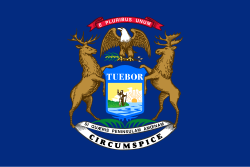| 4th Michigan Infantry Regiment | |
|---|---|
 Michigan state flag | |
| Active | June 20, 1861, to June 30, 1864 |
| Country | United States |
| Allegiance | Union |
| Branch | Infantry |
| Engagements | First Battle of Bull Run Peninsular Campaign Second Battle of Bull Run Battle of Chantilly Battle of Antietam Battle of Fredericksburg Battle of Chancellorsville Battle of Gettysburg Battle of the Wilderness Battle of Spotsylvania Court House Battle of Cold Harbor |
The 4th Michigan Infantry Regiment was an infantry regiment that served in the Union Army during the American Civil War. The 4th Michigan wore a very Americanized zouave uniform. This uniform consisted of a Federal dark blue 4 button sack coat, dark blue chasseur trousers, tan gaiters, and a maroon zouave fez with a light blue tassel.






